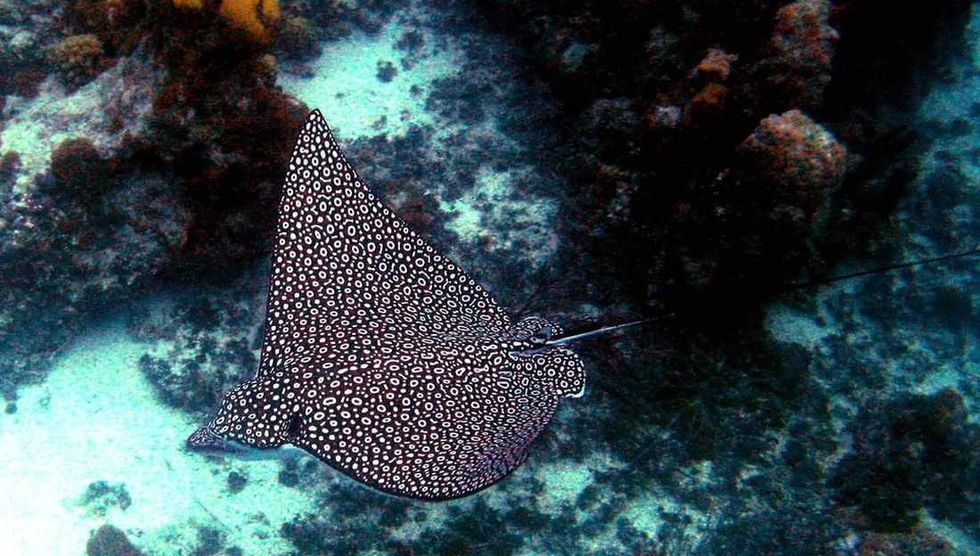Have you ever been fascinated by the gorgeous manta rays and sting rays in Finding Nemo? Then you would love to dwell in the interesting world of the spotted ray!
Known by the scientific name Aetobatus narinari, the eagle ray is a cartilaginous fish belonging to the family Myliobatidae. With breathtaking dark skin with a beautiful pearly pattern of white spots, these fish are considered to be the most beautiful rays of this species.
Found in the tropical regions of the Atlantic, the Mediterranian, the Pacific, and the Indian Oceans, spotted rays are an endangered species and are classified as Near Threatened, making their conservation the utmost priority.
Spotted rays or spotted eagle rays are often observed feeding on benthic organisms. These are organisms that live at the bottom of the sea, such as worms, small fish, and animals with shells such as clams, oysters, mussels, and other crustaceans.
Spotted rays are generally safe from being eaten, however, are at risk of being harmed by sharks such as the lion shark and the tiger shark. The biggest threat to this species is fishing, which is classified as the top reason for the endangerment of these rays.
In addition to their beautiful spotted skin, the members of this species are characterized by their large pectoral fins and long, sharp, whip-like tail. They also have a unique snout, rounded like a duck's bill.
Their large pectoral fins allow them to swim gracefully through the sea, very similar to a bird soaring across the sky. Considered to be very social fish, these rays swim together in large groups in perfect synchronicity- truly a sight to see!
Read further to learn some spotted eagle ray facts, and if you love marine creatures, check out our Port Jackson shark facts and rainbow shiner facts pages!
Spotted Ray Interesting Facts
What type of animal is a spotted ray?
Spotted rays or eagle rays are cartilaginous fish.
What class of animal does a spotted ray belong to?
Spotted rays or Eagle rays fish belonging to the Myliobatidae family.
How many spotted rays are there in the world?
Although the exact number of spotted rays (Eagle rays) in the world is not known, they are classified as near extinction by the IUCN. Hence, the number of spotted rays in the world is dwindling and they are in dire need of conservation.
Where does a spotted ray live?
Spotted rays or eagle rays are native to the Atlantic Ocean, the Caribbean, and the Gulf of Mexico. They are also found in tropical areas such as parts of the Pacific and Indian oceans, Morroco, and Denmark.
What is a spotted ray's habitat?
The spotted eagle ray habitat generally consists of shallow, warm temperate waters, with a gravelly seabed. They are also found near coral reefs and bay areas and occasionally wander into estuaries. They display high site fidelity, which means that they return to or stay in the same location throughout their lives.
Who do spotted rays live with?
While they are hunting or looking for food, spotted eagle rays are found alone or in small groups at the bottom of the ocean. However, when they are traveling through open water, they are found in groups of 50 - 100. They are considered to be very social with other members of this species.
How long does a spotted ray live?
It is speculated that spotted eagle rays can live up to 25 years.
How do they reproduce?
The reproduction cycle of this species begins with one or more males pursuing a female. Spotted eagle rays are ovoviviparous, which means that they give birth to live young that develop inside eggs in the mother's body.
Males approach females and the mating process begins. The average time of the mating process is in the range of 30 - 90 seconds. The female then undergoes a pregnancy period of around one year, following which she gives birth to a small litter of four pups.
What is their conservation status?
The spotted eagle ray has been classified in the IUCN Red List of Threatened Species as Near Threatened.
Spotted Ray Fun Facts
What do spotted rays look like?
Spotted eagle rays are generally flat, often compared to a 'disc' shape. They usually have blue/black dark skin with many small, white spots on them, forming a beautiful, contrasting pattern.
They also have long, wing-like pectoral fins which they use to swim gracefully across the water. Watching a spotted eagle ray jumping out of the water with these pectoral fins is considered to be a rare and breathtaking sight.
These pectoral fins are very broad with pointed tips and have spiracle patterns on them.
They are also known for their unique head and snout, which is broad, flat, and similar to a duck's bill. They have small teeth and a very long whip-like tail with venomous spines behind their pelvic fins.

How cute are they?
Spotted eagle rays are considered to be very breathtaking in nature, mainly due to their deep, patterned skin and their beautiful wing-like fins which make them seem like they are flying through the ocean. Their unique head and snout also make them look fascinating as they swim across the sea.
How do they communicate?
Spotted eagle rays communicate using physical movements and vibrations. They make use of their pectoral fins, tail, and head to communicate by moving them back and forth or by flapping them up and down. They also occasionally make loud sounds when taken out of the water by humans and grunt while they are inside the water to communicate.
How big is a spotted ray?
Spotted eagle rays grow to a maximum length of 20 ft (4.9 m) and width of 10 ft (3 m). This makes them twice the length of a common stingray.
How fast can a spotted ray swim?
Due to their massive pectoral fins, spotted eagle rays have the ability to swim very fast.
How much does a spotted ray weigh?
Spotted eagle rays are usually observed to be in the range of 400-500 lb (181-227 kg).
What are the male and female names of the species?
There are no specific names for males and females of this species. They are simply referred to as the spotted eagle ray male/female.
What would you call a baby spotted ray?
Baby spotted eagle ray is referred to as pup or a juvenile spotted eagle ray.
What do they eat?
The spotted eagle ray diet consists of marine animals that live on the ocean bed, such as mollusks, worms, small fish, cephalopods, crustaceans, and gastropods.
Are they poisonous?
Eagle rays have a very long tail that consists of many sharp and venomous barbs or spines located right behind their pelvic fins. Although the flesh and the bite of this species are not considered to be poisonous or venomous, their tails can inflict serious and sometimes fatal wounds on humans.
Would they make a good pet?
Eagle rays are large in size and are wild animals that require a large, oceanic habitat. They also have powerful, whip-like tails that consist of venomous barbs and spines. Hence, these rays would not make good pets. However, they are sometimes eaten by humans but mostly after they mature.
Did you know...
Spotted rays or eagle rays do not have regular teeth. They have a combination of plate-like teeth and papillae on the upper and lower parts of their mouths to feed on prey.
They have a set of dental plates on each jaw to crush their prey. They also have small, projection-like surfaces known as papillae which are used to separate the body of the prey from their shells.
These rays also have the ability to grow to a whopping 16.4 ft (5 m) in length and 507 lb (230 kg) in weight, making them one of the largest rays in the sea.
Another unique fact about these rays is that they have the ability to push their body out of the water, jumping in the air while swimming near the upper surface of the sea. This allows them to escape predators and other threats.
Watching the spotted eagle ray flying out of the water is considered to be a breathtaking sight. Some other marine animals that are known for jumping out of the water are the Sei whale and striped dolphin.
Spotted eagle rays have a dark top surface and a white underbelly which acts as a form of camouflage using countershading. Countershading is a common phenomenon observed in fish, where one side is dark while the other is light.
This allows them to blend into the sea, helping them remain hidden from larger predators. The yellowfin tuna is another fish that exhibits countershading.
In addition to larger predators such as sharks, spotted eagle rays are highly threatened by human activities such as fishing. In fact, Fishing is the number one cause of endangerment to the spotted eagle ray according to the IUCN.
If these rays are taken out of the water, they are known to make loud, piercing sounds until they are returned to the sea.
What are the different types of spotted rays?
Different types of spotted rays include the white spotted eagle ray, the blue spotted ray, the eagle spotted ray, the spotted leopard ray, the blue-spotted ribbon tail ray, the blue spotted sting ray, the white-spotted eagle ray, the blue and white spotted eagle ray, the great barrier reef spotted manta ray, and the spotted Florida eagle ray.
How do spotted eagle rays protect themselves?
Spotted eagle rays use their long tails to protect themselves from predators and other threats. Their tails consist of several venomous, sharp spines that they use to sting their predators or prey. The venom in these spines often leaves their predators immobilized, allowing them enough time to escape.
Another fish that has a sharp, venomous tail is the scorpionfish. These rays also have the ability to jump out of the water while swimming near the surface. This helps them escape predators and other threats.
Here at Kidadl, we have carefully created lots of interesting family-friendly animal facts for everyone to discover! For more relatable content, check out these eel facts and longnose gar facts pages.
You can even occupy yourself at home by coloring in one of our free printable spotted ray coloring pages.










